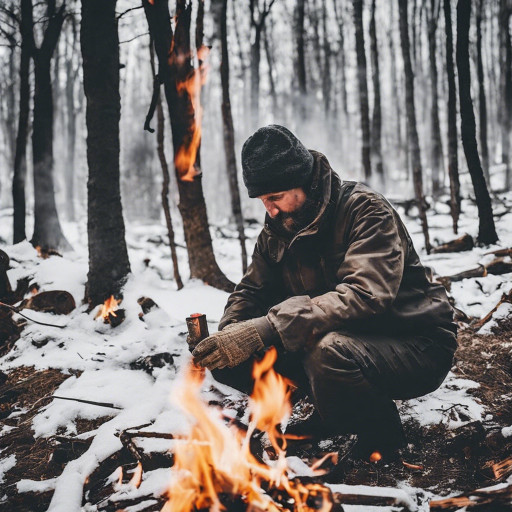Master Proven Techniques to Start Fires Effectively in Extreme Cold Weather
Starting a fire in freezing temperatures is not just a skill; it is an essential survival tactic when faced with the harsh realities of winter, characterized by its frigid temperatures and biting winds. As a passionate survivalist, you understand that fire is crucial for maintaining body warmth, providing light, and cooking food. However, lighting a fire in icy conditions presents unique challenges that require specific techniques and strategies. In this comprehensive guide, we will delve into the most reliable and effective methods for igniting flames in cold weather, empowering you with the knowledge and skills necessary to conquer the chilling grips of winter and thrive in the wilderness.
Essential Fire Starting Gear: Equip Yourself for Cold Weather Adventures
Before setting out on your winter wilderness adventures, it’s imperative to assemble the right gear and supplies that can dramatically boost your chances of survival. A well-prepared fire-starting kit can be the decisive factor in overcoming adverse weather conditions. Ensure that your kit contains the following crucial items:

a. Firestarters: Having reliable tools such as waterproof matches, storm-resistant lighters, and fire-starting rods is essential for ensuring ignition, even under challenging conditions like wind and dampness. Carrying multiple options will instill confidence in your ability to start a fire, no matter the obstacles you face.
b. Dry Tinder: Finding dry tinder in freezing temperatures can be a formidable challenge. To address this issue, pack highly flammable materials such as birch bark, fatwood shavings, and cotton balls soaked in petroleum jelly. These materials not only ignite rapidly but also significantly enhance your chances of successfully starting a fire when temperatures plunge.
c. Kindling: To build a strong base for your fire, gather dry sticks, twigs, and leaves. It is crucial to ensure these materials are completely dry because any moisture can hinder ignition and lead to frustration. Properly prepared kindling is vital for transitioning from tender flames to a more robust fire.
d. Fuel: Sourcing dry firewood in cold temperatures can be both a tiring and time-consuming task. Therefore, having a sufficient supply of dry firewood ready ahead of time is essential for maintaining a consistent fire over a longer period, allowing you to stay warm and cook food comfortably during your winter excursions.
Strategically Choose the Best Location for Your Fire to Enhance Efficiency
When temperatures drop significantly, selecting the optimum location for your fire can provide substantial benefits. Look for sheltered areas, such as rock formations or dense shrubbery, to minimize exposure to harsh winds. By positioning your fire near a natural windbreak, you not only reduce heat loss but also increase the likelihood of maintaining a steady flame. Additionally, consider constructing a small wind-resistant shelter using logs or a tarp to protect the fire from precipitation and help retain warmth, ensuring greater comfort and safety during your outdoor adventures.
Utilize the Layering Technique for Sustainable and Effective Fires
A key technique for successfully starting a fire in cold conditions is mastering the layering of your materials. To build a fire that burns continuously, it is essential to use three foundational layers: tinder, kindling, and fuel. Here’s a breakdown of each layer and its importance:
a. Tinder: The foundational layer, tinder, consists of materials that ignite quickly and easily. Use fine, dry substances such as grass, paper, or the previously mentioned birch bark to ensure a vigorous initial flame. An ample quantity of tinder is crucial for achieving successful ignition, especially in colder environments.
b. Kindling: This layer comprises small sticks and twigs that catch fire quickly and provide sustained heat. Gradually introduce kindling to your flame, ensuring enough space between pieces to promote airflow and enhance combustion. This step is crucial for transitioning from small flames to a larger, more stable fire.
c. Fuel: Once you have a steady flame established, gradually add larger pieces of firewood. Ensure the wood is dry, as it will burn longer and produce more heat. Increase the size of the wood pieces incrementally, allowing the flames to grow stronger before introducing larger logs. This strategic approach to layering facilitates a stable and sustainable fire.
The layering technique creates a structured setup that allows the flames to expand and sustain themselves effectively. Always ensure you have an adequate supply of each component readily available to facilitate a smooth transition from tinder to fuel, ensuring a successful fire even in challenging conditions.
Enhance Your Fire-Starting Success with Proven Aids and Techniques
In frigid weather, utilizing additional fire-starting aids can significantly improve your chances of igniting a fire against the challenges posed by low temperatures. Here are some effective methods to consider:
a. Fatwood: Often referred to as nature’s firestarter, fatwood is resin-rich pine wood that ignites easily and burns with intense heat. You can gather these naturally occurring sticks from fallen pine trees or purchase them from outdoor supply stores. A few pieces of fatwood can dramatically increase your odds of successfully starting a fire in particularly cold conditions.
b. Alcohol-Based Hand Sanitizer: Surprisingly effective, alcohol-based hand sanitizer is highly flammable and acts as an accelerant. A small amount applied to your tinder or kindling can help ignite a fire quickly, even in damp conditions, simplifying the fire-starting process and ensuring warmth when it is needed the most.
c. Char Cloth: Char cloth is a specially prepared fabric that ignites easily from sparks, making it an excellent tool for starting fires using flint and steel or a lighter in tough situations. Its lightweight and portable nature makes it an ideal addition to your fire-starting kit, ensuring you are always prepared.
Incorporating these fire-starting aids into your cold-weather toolkit can significantly enhance your chances of success when facing particularly challenging conditions, allowing you to adapt effectively to your environment.
Explore Effective Fire Techniques Perfectly Suited for Cold Weather Conditions
As a committed survivalist, continuously refining your skills is essential for your success. Here are two fire techniques that excel in cold weather conditions:
a. Swedish Torch: Also known as a Canadian Candle or Finnish Fire Log, the Swedish Torch is an exceptionally effective fire-starting method. This technique produces a stable and long-lasting flame, perfect for combating winter's chill. To create a Swedish Torch, find a log about knee-height and cut several vertical slits along its length. Place tinder in these slits and ignite it. The log will serve as a consistent fuel source, allowing the flame to persist for an extended period, ensuring warmth and safety.
b. Dakota Fire Hole: When faced with strong winds, the Dakota Fire Hole method proves to be highly effective. This technique involves digging a hole and tunneling horizontally underground to create an airflow vent. This design harnesses the wind to enhance airflow, resulting in a more efficient fire that is less likely to be disrupted by gusts. Furthermore, the Dakota Fire Hole method effectively reduces visible smoke while conserving fuel, making it an excellent choice for stealthy fire building.
Regardless of the method you choose, always prioritize safety and responsible fire management to minimize risks and ensure a successful fire-starting experience.
Successfully igniting a fire in cold weather demands meticulous planning and execution. By following these steps—preparing a reliable fire-starting kit, selecting an optimal location, mastering layering techniques, utilizing fire-starting aids, and embracing specific fire strategies—you will significantly increase your chances of success. Remember, practice is key, so consistently train to refine your skills and boost your confidence. With these essential tactics for igniting fires in freezing conditions at your disposal, you’ll be well-prepared to face even the harshest winters that nature can throw at you. Stay warm, prioritize safety, and keep the flames of survival alive!
The post Fire Starting Methods for Survivalists in Cold Weather appeared first on Survival Bite.
The Article Fire Starting Techniques for Cold Weather Survival Was Found On https://limitsofstrategy.com


What a timely and informative guide! Preparing for cold weather adventures can really shift the entire outlook on outdoor survival and enjoyment. As someone who has found themselves in the snowbound wilderness more than a few times, I appreciate the emphasis on mastering fire-starting techniques in extreme conditions.
Mastering fire-starting techniques in extreme conditions can truly be a game changer. It’s fascinating how fire can transform a cold, dreary situation into a comforting haven. Have you found any particular methods that work best for you when the conditions are less than ideal? I’ve heard from others that using natural tinder, like dry grass or birch bark, makes a difference.
Starting a fire in extreme cold is truly a test of both skill and ingenuity. I remember my first winter camping trip; I underestimated just how damp everything could become, even in freezing conditions. It was a lesson in patience as I experimented with different materials—using dry pine needles and birch bark made a world of difference!
Your blog post raises an important topic that so many survival guides often overlook—how uniquely challenging it can be to start a fire in extreme cold. I’ve had my own share of experiences trying to ignite a flame in freezing temperatures, and it often turns into a lesson in patience and the importance of preparation. I once ventured into a particularly snowy area only to realize that my standard kindling wasn’t sufficient. The damp and cold simply overwhelmed my usual methods.